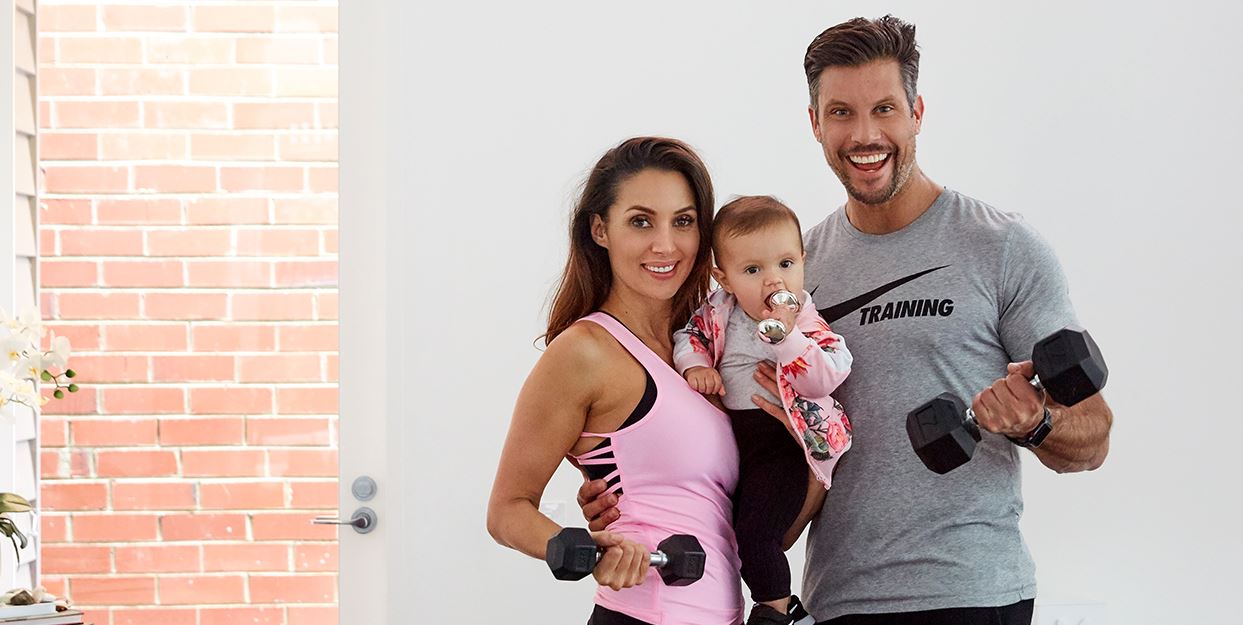If you’ve been finding it hard to lose your baby weight, you’re not alone. Each week Sam and his crew receive hundreds of questions from mums with newborns and infants, asking how to get back to their pre-baby weight. So many mums tell us they didn’t expect it to be so hard because ‘everyone’ said the baby weight would just fall off during breastfeeding and their tummy would ‘snap back’ naturally.
After helping thousands of new mums get healthier at home, believe us when we say it is totally normal if you’re struggling to get back to your pre-baby weight. It’s also fairly normal if you’re still wearing your maternity clothes several months after having your baby. The good news is that it’s never too late to make small, healthy changes to encourage your postnatal body to let that old baby weight go – your body just needs a gentle little nudge in the right direction.
Lots of mums worry that there might be something wrong with them if they can’t fit into their pre-baby clothes as soon as they’ve given birth – especially because all those yummy mummies on Instagram seem to ‘snap back’ so easily! The truth is that not everyone loses all their baby weight straight away.
Ready for Sam & Chloe’s guide on what to do if you can’t lose your baby weight?
We know it’s not always easy, but losing baby weight CAN be simple. From postnatal exercise to healthy eating, the best way to strengthen and flatten your post-baby tummy muscles, right through to free lose baby weight recipes and, of course, the number #1 way to ditch that extra baby weight once and for all, Sam Wood and 28’s resident postnatal physio, Chloe Lorback share their top tips to get you back on the road to feeling like your old self again.
Contents
Sam shares 5 reasons why you might not be losing your baby weight
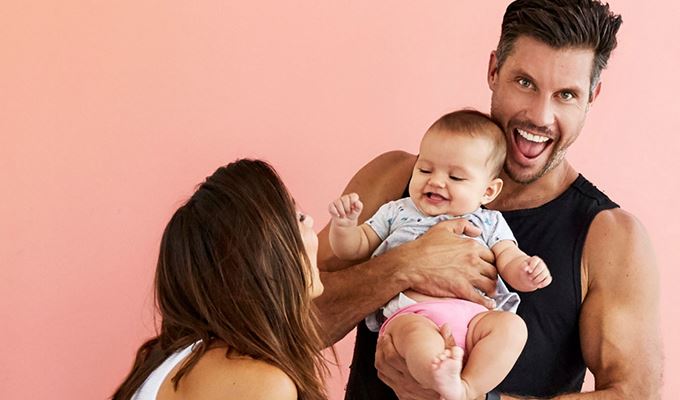
#1 Not enough sleep
Everyone knows sleep plays an important role in losing weight, but we also know that sleep is often compromised when you have a young baby! If you find you are making nutritious food choices, you’ve cut out unhealthy snacks and you’re getting regular exercise, but you’re still not losing your extra baby weight, it might be time to look carefully at the quality of your sleep.
If your baby is still waking several times a night, it might be time to chat with the maternal child health nurse to help you with some sleep strategies.
Every baby is different, so don’t panic if your baby isn’t sleeping through the night but it seems like everyone else’s baby is. My cheeky boys woke once or twice a night for the first 9 months of their lives. Just when I was at my wit’s end, they suddenly slept through. Those extra hours of uninterrupted sleep each night made all the difference to my energy, and that’s when I noticed the last few kilos dropped off. Plus because I felt more energy I found much more motivation to exercise.
#2 Your portion sizes might need to come down if you’ve stopped breasfeeding
It might be time to take a closer look at your portions. Have you recently weaned or dropped a feed, but haven’t adjusted your portion sizes down? How about snacks? Sometimes, when you feel too tired to prepare meals, or you’re bored, it’s easy to find yourself snacking throughout the day. All these snacks add up though, so if your baby weight isn’t budging, skip some of the snacks, or swap them for fresh, simple cut up veggies or a small piece of fruit.
Breastfeeding definitely warrants an extra snack or two but when your bub starts solids, this often coincides with a drop in feeds. So you might need to reduce your portion sizes to match the reduced calories being used to produce breast milk.
#3 You may not be drinking enough water
It’s important to avoid dehydration, for a few reasons. Firstly, dehydration can sometimes be misinterpreted as feeling hungry. Secondly, some studies say your body needs between 2 – 4 litres per day (depending on your size and weight) to keep your metabolic processes working effectively. So make sure you are drinking at least 2L of water daily and carry your water bottle with you everywhere so you can sip regularly during the day. Don’t wait until you feel thirsty, as thirst can be a poor indicator of whether you’re sufficiently hydrated.
A simple way of checking if your body is well hydrated is to check the colour of your pee, if it’s pale yellow, that’s a good sign, and if it’s dark, it’s not!
#4 You’ve reached a fitness plateau
Are you doing the same exercises, day in, day out? If you walk the same 15-minute circuit each day, eventually your body gets used to it and expends minimal energy to complete it. It’s important to mix up your exercise routine, including cardio, strength and core work, so keep your body guessing and keep churning through those calories.
#5 You might simply need more time to recover and heal (and that’s totally normal!)
Sometimes your body just isn’t quite ready yet for the stress and strain of exercise, and you just need to give yourself a bit more time before you embark on your weight loss mission. Common reasons to wait a bit longer before exercising more include having had a complicated delivery, having difficulty with breastfeeding or having limited support around you.
Jump to: Simple tips to lose baby weight naturally
How long does it normally take to lose weight after having a baby?
There really isn’t a “normal” when it comes to losing your baby weight. As with all things, some women seem to snap back quicker, while others take longer. How fast you lose your baby weight and get your pre-baby shape back doesn’t seem to be impacted by your pre-pregnancy fitness or your age, so it’s important to know that the only ‘normal’ is that everyone loses baby weight at different speeds.
No pregnancy is ever exactly the same, so it stands to reason that no postnatal weight loss journey is the same either.
Of course, it’s important to have some kind of a guideline, so we generally recommend it can take about 9 months to get back to something like your pre-baby shape. After all, if it took 9 months to grow your baby, and your body went through 9 months of significant physical changes, inside and out, then we would expect you to take at least 9 months to feel like you’re getting back to your pre-pregnancy shape.
TIP: Try to incorporate more incidental activity into your day, it is such an easy way to burn a few more calories without really trying!
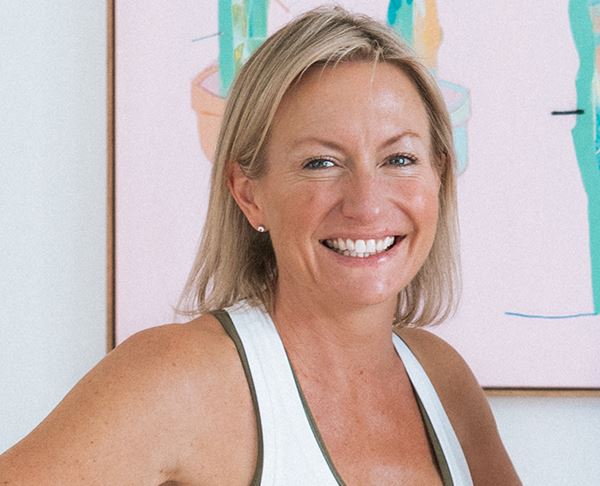
It’s a miracle to grow a human in our tummy; but along with this amazing miracle and a wonderful bundle of joy comes some physical changes that we don’t enjoy, like stretched skin and muscles, and all that extra weight our body wanted us to gain to ensure we could feed our bubba. And, although we feel proud of our bodies for creating a beautiful, nurturing home for our babies, we want that extra weight gone… now!
Chloe
Do your best to see your post-pregnancy weight loss as a marathon, not a sprint. Be patient. The good news is that it’s a marathon you WILL win, as long as you have the right coaches by your side… like Sam and me!

The secret to losing baby weight naturally?
The short answer is: eat healthily, do more incidental exercise and… build those muscles!
Over the past 20 years, a lot of my female training clients used to worry that building muscle meant getting bulky – but it doesn’t have to. Lean muscles don’t add bulk. It’s actually really difficult for women to bulk up, but a bit of extra muscle tone looks and feels great.
The good news is you don’t need to bulk up, you just need to tone up.
As your lean muscle mass increases, the rate at which you burn energy (calories) increases. Increased lean muscle mass will accelerate your basal metabolic rate (BMR) and when your metabolism increases, it helps you to burn more energy throughout the day.
Lean muscle makes you feel stronger, leaner and… they help you burn more calories naturally, even while you sleep!
A quick postnatal timeline to exercise
After 8 weeks: Assuming you’ve gotten the all-clear to return to exercise from your doctor (which is usually 6-8 weeks postnatal), start off with gentle, low impact postnatal training to get back into the groove of exercise, so your joints and muscles can get acclimatized to being active again.
After 3 months: it’s usually safe to start adding some resistance to your post-baby workouts. Start slowly and add weight-bearing load gradually. Listen to your body, and if anything hurts, stop immediately.
After 6 months: you may feel ready to try 28-minute HIIT resistance workouts. High-intensity interval training is a quick, easy and effective way to tone up and lose weight. But, before you try HIIT after having a baby, you’ll need to strengthen your physical foundations with postnatal-safe low impact exercises and light weights.
ALWAYS LISTEN TO YOUR BODY: Lifting weights and HIIT will add pressure to your pelvic floor muscles, so if your pelvic floor still feels weak, or if you are experiencing any sense of pelvic heaviness or incontinence while exercising, delay adding weights or impact to your routine for a bit longer.

Healthy go-to snacks for mums trying to lose baby weight
When you are tired, it can be easy to reach for sugary snacks, coffee or soft drinks to give you a quick energy kick. If you want to feel healthier, have more energy and lose weight, replace sugary snacks with healthier options. Here are a few quick ideas for you:
- a piece of fruit (fresh not dried)
- cheese & crackers
- a berry yummy smoothie

Meet Terleah, A 28er on our postnatal program
Kilos, centimetres and dress sizes… Gone!
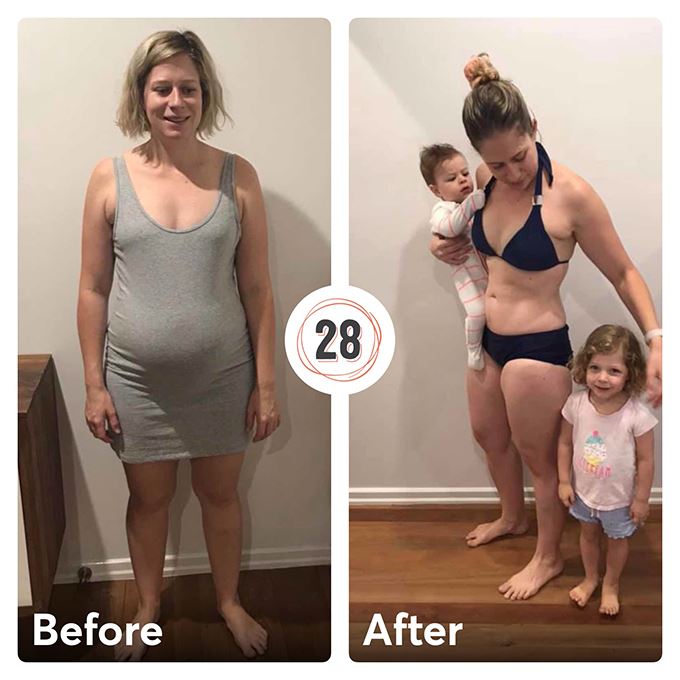
I love that at 32, with two children, I am currently the fittest and healthiest I’ve ever been. The 28 program is so fantastic and it really is just our way of life now. My transformation is about more than lost kilos, centimetres and clothes sizes. It’s about being the best version of myself, for myself and my family.
Terleah, 28er
How to lose weight naturally after pregnancy
Losing weight after pregnancy will usually happen fairly naturally once you are making nutritious food choices and you’ve started to move your body more regularly.
Here are our top tips to losing your baby weight naturally, with just a few simple lifestyle changes.
- Move more.
Walking, cycling, dancing, or even housework – incidental exercise is great for new mums who want to lose baby weight! Choose something you love and do more of it! Catch up with your friends at the park rather than the cafe, and stroll while you chat. Head to storytime at the local library and walk there instead of taking the car. - Avoid sitting for longer than 45 minutes at a time.
Get more movement in your day by reducing how long you sit. Trying to change position regularly to get your muscles and joints moving, so you’ll avoid back pain and other postural aches, PLUS you’ll be burning more calories, naturally! - Eat nutritious meals and choose healthy snack choices.
It’s a no brainer – make healthy food choices, and it’s not just you who benefits! If you’re breastfeeding, essential vitamins and minerals from the food you eat are passed on to your baby. When your kids are older, modelling healthy food choices to them sets them up for success to become healthy kids. - Get some quality sleep.
It sounds impossible, but if you can, try to go to bed earlier, ask your partner for help with the ‘dream feed’, and get some quality zzz’s under your belt. The extra energy you gain from improved sleep helps you to make better food choices, and the extra energy means you’ll also be more in the mood to exercise.

What is incidental physical activity?
It’s any small physical activity you might do in your daily life that isn’t specifically ‘working out’. For example choosing to walk 2 kilometres around the park specifically for fitness or recreation is planned exercise, whereas walking 2kms on foot to reach your local health service is incidental exercise.
Adding more incidental activity into your day is an easy, natural way to build your fitness and return to an active lifestyle again.
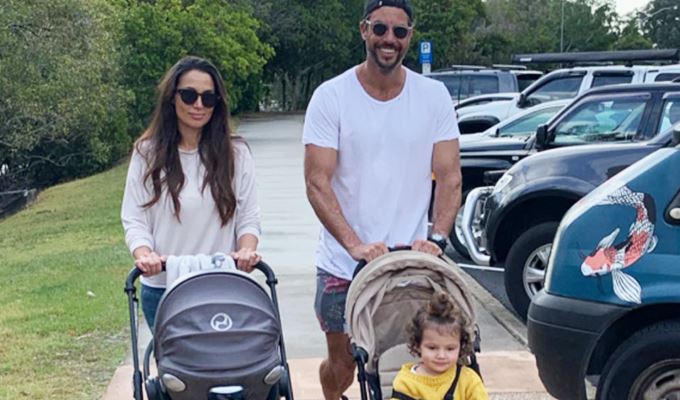
Incidental exercise: an easy way to drop some post-baby body kilos
Moving your body with intention is important, as is ensuring you schedule time to workout and rebuild your strength. I know that some days it’s going to be hard to get around to doing your daily workout, but there’s another activity you can do to help drop those extra kilos, and it’s called: incidental activity.
Here are some ideas to increase your incidental activity each day:
- When you’re brushing your teeth, do a few squats
- When you’re cooking dinner: do some calf raises
- When bub is playing, get down on the floor and join in
- When you go down the hallway, bounce, don’t walk (but not if you’ve recently given birth!).
All exercise adds up and, whether it’s an incidental activity or a scheduled workout, you will soon feel your strength and energy start to return, with the added bonus of losing that extra baby weight!
Remember, if you don’t have a lot of time for exercising, and you’re struggling to get back in shape, just focus on making small, sustainable lifestyle changes, and the weight loss will come.
Chloe, our postnatal physio, answers your questions about getting fit after multiple pregnancies!
Is it harder to lose weight after your 2nd baby?
Not usually, but sometimes. For many women, losing their baby weight after the second baby is quicker and easier the 2nd time around mainly because, with two kids, you are so busy you rarely get a chance to sit down! Entertaining a toddler while you’re nursing a newborn can be a tiring job, you’re likely to be moving around a lot more than you did when you only had the one baby – so you’re getting in a lot more incidental exercise. You also know what you’re doing now, so it can feel easier bringing home your newborn as you’ll probably already have an established feeding and sleeping routine that your new baby naturally becomes a part of – and this means you are probably regulating your own feeding and sleeping schedule better the second time around!
Of course, not all women have the same experience of losing weight quickly after their 2nd baby. A number of mums joined our program because they found it tricky to lose their weight after baby number two, mainly because their regular exercise plans have been disrupted, and the battle to get enough sleep begins all over again. Just remember “this too shall pass” and while it can feel like your weight loss progress is slow, and there isn’t any time for mama, just focus on making small, sustainable healthy changes – like healthier food choices and more incidental exercise, and your post-baby weight loss will come.
Does your body shape & weight change more after your second pregnancy?
Often, yes. It can take longer to get back into your old clothes or lose those last couple of pregnancy kilos. Your abdominal skin and muscles stretch a little more than they did the first time around, so it can take longer for them to tighten up and shrink back in. This can make you feel like you still look pregnant, even months after your baby is born, which can be pretty disheartening!
Some mums tell us they feel frustrated they never lost the muffin top from their first pregnancy, so they hadn’t gotten back into shape before falling pregnant again. Is it too late for them? No! Can you get back to your pre-pregnancy weight, no matter how many babies you’ve had? Yassss!
Sam Wood & Chloe Lorback
xx
Is your physical recovery time the same after second or third pregnancy?
No. When you have your second or third baby you’ll likely find your abdominal muscles will have stretched a little more than they did after the first pregnancy and so your physical recovery can often be a little slower. It might also take you longer before you feel ready to jump back into exercise. And, because your abdominal muscles are more stretched than they were after your first pregnancy, you need to be mindful of not pushing yourself too fast.
Is exercising any different after a second or third baby?
Early on, yes, usually. After multiple pregnancies, even if you feel your body has generally bounced back well, it can still feel ‘weird’ if you try to walk longer distances, jog or return to exercise too soon. You should take things very slowly because your pelvis and lower back joints are more vulnerable to injury compared to after your first pregnancy; give yourself plenty of time and delay any medium or high impact exercises until your core muscles tighten up a bit.
The good news is that, even if you’re feeling like your progress is slow after your second or third baby, you will get there, you just need to be patient with yourself.
What exercise plan should I do if I’m planning on having another baby soon?
If you’re planning on having another baby, you should try to really get your body back to tip-top physical condition before you fall pregnant again. Work on your core and learn how to activate your pelvic muscles as it will help you avoid a lot of pelvic instability issues that multiple pregnancies can often bring. And, no matter when you plan to be pregnant again, the sooner you build your pelvic strength up, the sooner you’ll feel strong, stable… and safe when you jump!
Our online postnatal program allows you to swap over to the pregnancy fitness program with a click of a button, just as soon as you get the happy news!
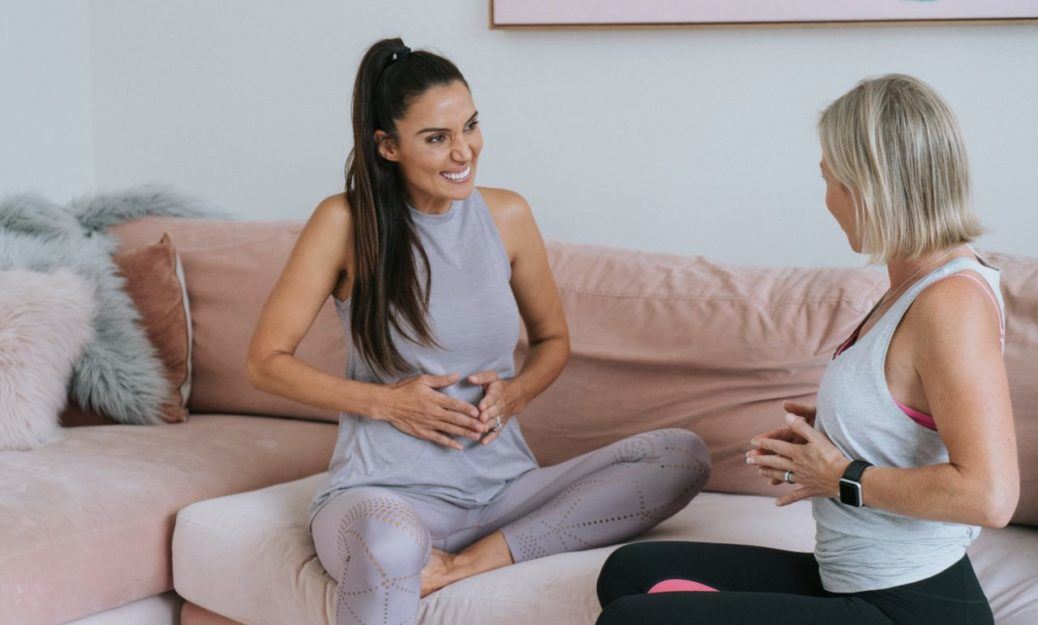
How do I know if I am activating my pelvic floor muscles correctly?
- Picture the muscles of the pelvic floor as a muscular sling running from your tailbone to your pubic bone.
- Imagine the sensation of trying to hold in wind from your back passage.
- Squeeze the muscles upwards and inwards as if you are trying to avoid passing wind.
- If you can, bring the pelvic floor lift further forwards as though you are also trying to stop the flow of urine.
TIP: You should be able to feel your muscles working in a standing or sitting position, whether lying on your back or lying on your side. You might feel a gentle indrawing of your lower tummy muscles, but essentially you shouldn’t be able to see or feel any other muscles moving.
The key to ongoing weight loss is to ensure that you keep challenging your body, by exercising at an intensity which challenges you.
Those (slightly boring but very important) deep abdominal ‘drawing in’ exercises, together with your pelvic floor exercises, are so important when you are getting back into exercise, particularly if you are trying to lose weight. You need support throughout your whole core “cylinder” – the bottom (pelvic floor muscles); the sides (transversus abdominis muscle); and the back (multifidus) before you can safely increase your exercise intensity.
It’s similar to lifting weights, as you get stronger, you’d need to lift heavier weights to continue to improve. With weight loss, you need to continue to mix up the intensity of your physical activity, once you have built a strong core foundation, to keep your metabolism firing and for your body to rebuild muscle strength. That’s why the 28 by Sam Wood program works so well for new mums. It’s designed to be fast and simple, with metabolism-boosting HIIT workouts and totally different exercises each day. You’ll be taken through all the right muscle toning moves and you’ll have easy to follow meal plans that ticks all the right nutritional boxes.
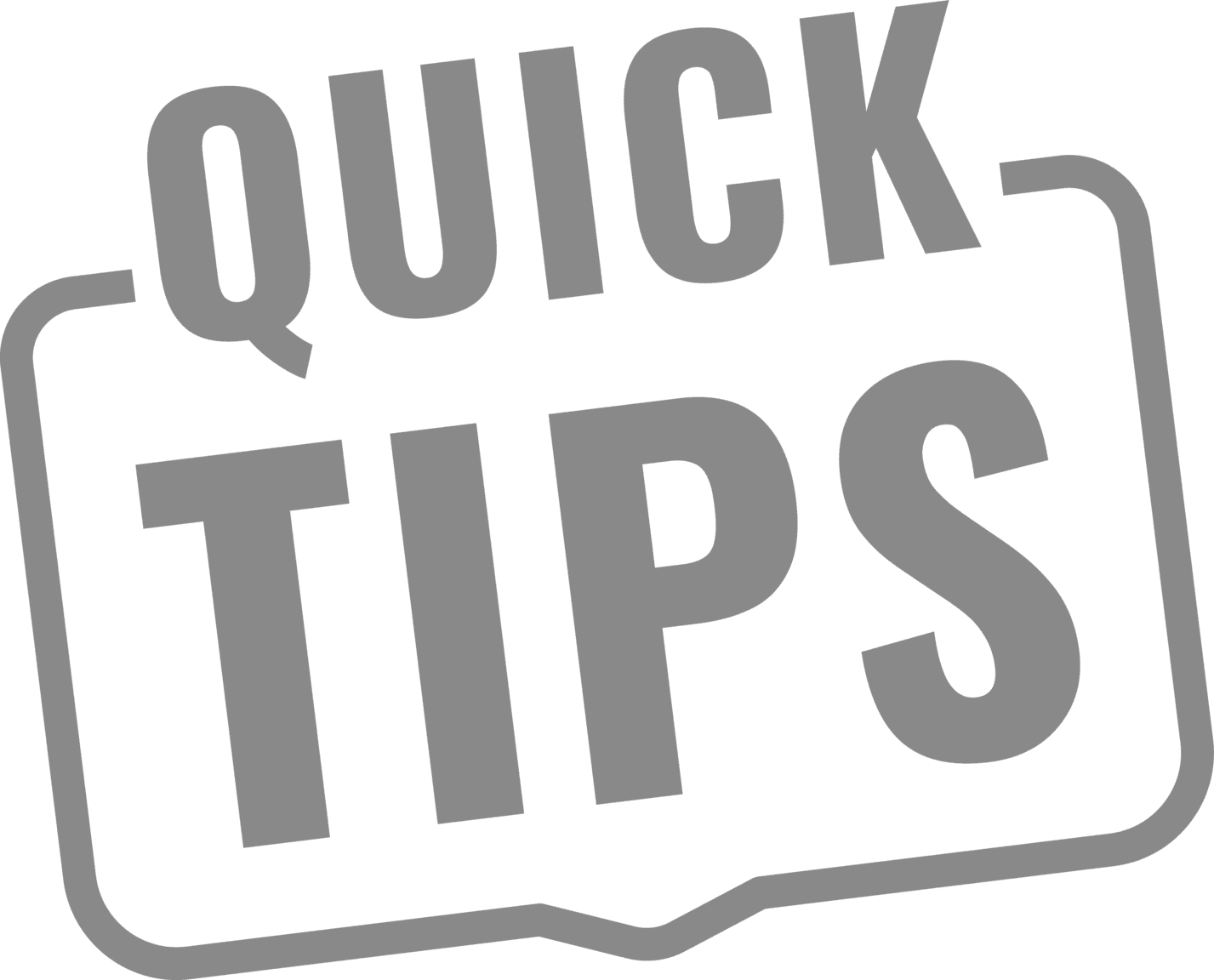
Struggling to feel your pelvic floor muscles activate?
Sometimes, when your muscles are weak, it is easiest to feel them working when you’re lying down.
What NOT to do when exercising your pelvic floor muscles:
- Don’t squeeze your buttock muscles (that’s not your pelvic floor)
- Don’t squeeze your legs together (that’s not it either)
- Don’t hold your breath (this can be a challenging habit to break!)
- Don’t move your spine or hips

Did you know?
If you make an extra effort to do your core exercises early on in your pregnancy, often you’ll be stronger at week 35 than you were in week 5!
Sam says you need these 4 things to lose your baby weight for good
#1 Consistency
The key to losing your excess baby weight is to make healthy eating and healthy physical activity a daily habit. Speaking of activity…
#2 More movement, every day
Small doses of movement throughout the day can really boost your overall daily exercise, and then, when you’re ready to add in your daily HITT resistance workouts, you will definitely start to see some weight loss, assuming, of course, you’re following tip #3!
#3 Eat for nutrition
Nutrition is vitally important. You need to be eating a variety of nutritious food to ensure your intake of vitamins and minerals is sufficient, particularly if you are breastfeeding. And if you’re no longer breastfeeding, and you’re struggling with your weight then it’s equally important to ensure your body has all the right nutrients it needs to give you energy and help you lose weight, which leads me to tip #4…
#4 Cut the sugar
Sugary snacks will make you feel more tired in the long run, so plan your meals and make sure you keep your energy level consistent throughout the day with healthy meals and snacks. When you have more energy, you are more likely to do your workouts, which builds muscle and gives you more energy, so it’s like a healthy upward spiral! And if you need a bit of extra motivation, remember the big picture: a healthier, happier mum, always leads to a healthier, happier family!
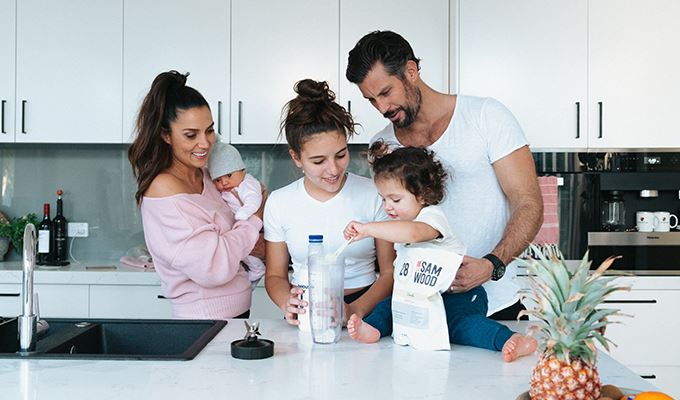
The best way to lose your post-baby belly
If your baby belly is hanging around for longer than you had hoped, you’re not alone. The truth is: there are no shortcuts to losing your baby belly. It takes time and consistent effort to regain your abdominal strength and get back in shape, but it’s worth it.
You’ll lose your baby belly once you can consistently make healthy food choices, move more every day, plus do daily exercises to strengthen your pelvic floor and abdominals.
In addition to your postnatal workouts and increased incidental activity, you should keep up your daily pelvic floor exercises. When you regularly activate your pelvic floor muscles, you’re also strengthening your deep abdominal muscles, which helps to flatten your tummy too. Once the surrounding abdominal muscles are working properly again, your posture will improve and your pelvis and lower back joints will be protected. As your baby belly starts to disappear and your abdominal strength returns you’ll feel so much stronger and you’ll also be far less vulnerable to injury, ready to handle whatever life throws at you.
Is it harder to lose baby weight in your 30s?
Sometimes. Although age can have an impact – and Snez certainly said she found it harder to get back into shape after little Willow compared to when she had Eve in her 20s – the good news is that whether you are in your 20s or your 30s the same postnatal weight loss rules apply. If you make small, consistent healthy changes to your lifestyle you will see results! You can’t rush your post-childbirth recovery though, as there really is no quick-fix. So enjoy the journey with your little one, and focus on progress, not perfection. You’ll get there!
To regain your pre-pregnancy body shape more quickly (at any age):
- be conscious and mindful of what you’re eating
- choose high quality, nutritious food
- move your body every day
- avoid unhealthy snacks
Is it harder to lose baby weight in your 40s?
Often, yes, but there are some simple ways to overcome this. Although mums of every age lose their excess baby weight in basically the same way (eat healthily, move more, avoid unhealthy snacks), there is no denying it can feel a little harder after 40. If you’re in your 40s and you feel it’s harder to lose the baby weight compared to when you were younger, it might be because you have less muscle mass now, compared to your 20s.
If you’re a recent mum in your 40s you can rebuild your lean muscle so you can burn more calories, naturally!
VIDEO: Get your energy up with this beginner’s postnatal workout at home
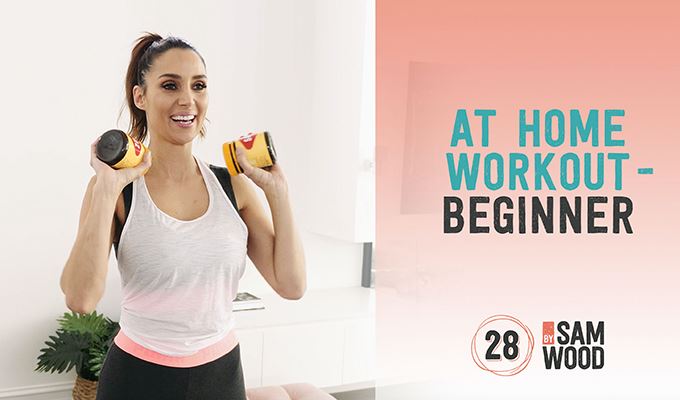
This is a great beginner workout to try once you’ve been given your doctor’s clearance. The suggested reps are listed next to each individual exercise, but as you regain strength and fitness try each exercise for 40 seconds on, 20 seconds off and repeat the sequence 4 times over – the perfect beginner 28 Minute Workout!
- Supported Squat (20 reps)
- Elevated push up (10 reps)
- Curl and press (20 reps)
- Boxing (30 seconds)
- Glute bridge hold (30 seconds)
- Slow alternating leg lowers (30 seconds) *Skip exercise #6 if abdominal separation has occurred
- Plank (30 seconds) *Do this on your knees if abdominal separation has occurred
Your muscle mass plays an important part in determining how many calories your body burns. Unfortunately, somewhere in our 30s, we start to lose muscle mass. Once we hit middle age, muscle mass diminishes by up to about 1% a year in a process called sarcopenia. But we CAN do something about it! Luckily it’s been proven that it’s never too late to rebuild muscle strength and endurance by doing resistance training.
So, as long as you’ve gotten the all clear from your doctor to engage in vigorous exercise, the easiest way you can rebuild your calorie-burning lean muscle is though 28-minute HIIT resistance workouts.
Good luck mums, and don’t forget we are here to support you. Reach out to our crew if you have any questions while you’re losing your baby weight. You can do this!
Sam & Chloe
xx
Ready to join our 28 family?
Designed by myself and my team of nutritionists and women’s health experts, our postnatal is safe and effective for new mums. It’s gentle enough when you’re just getting started, but tough enough to give you great results. The best part is that you can do it all from the comfort of your own home for less than $2.50 a day.

